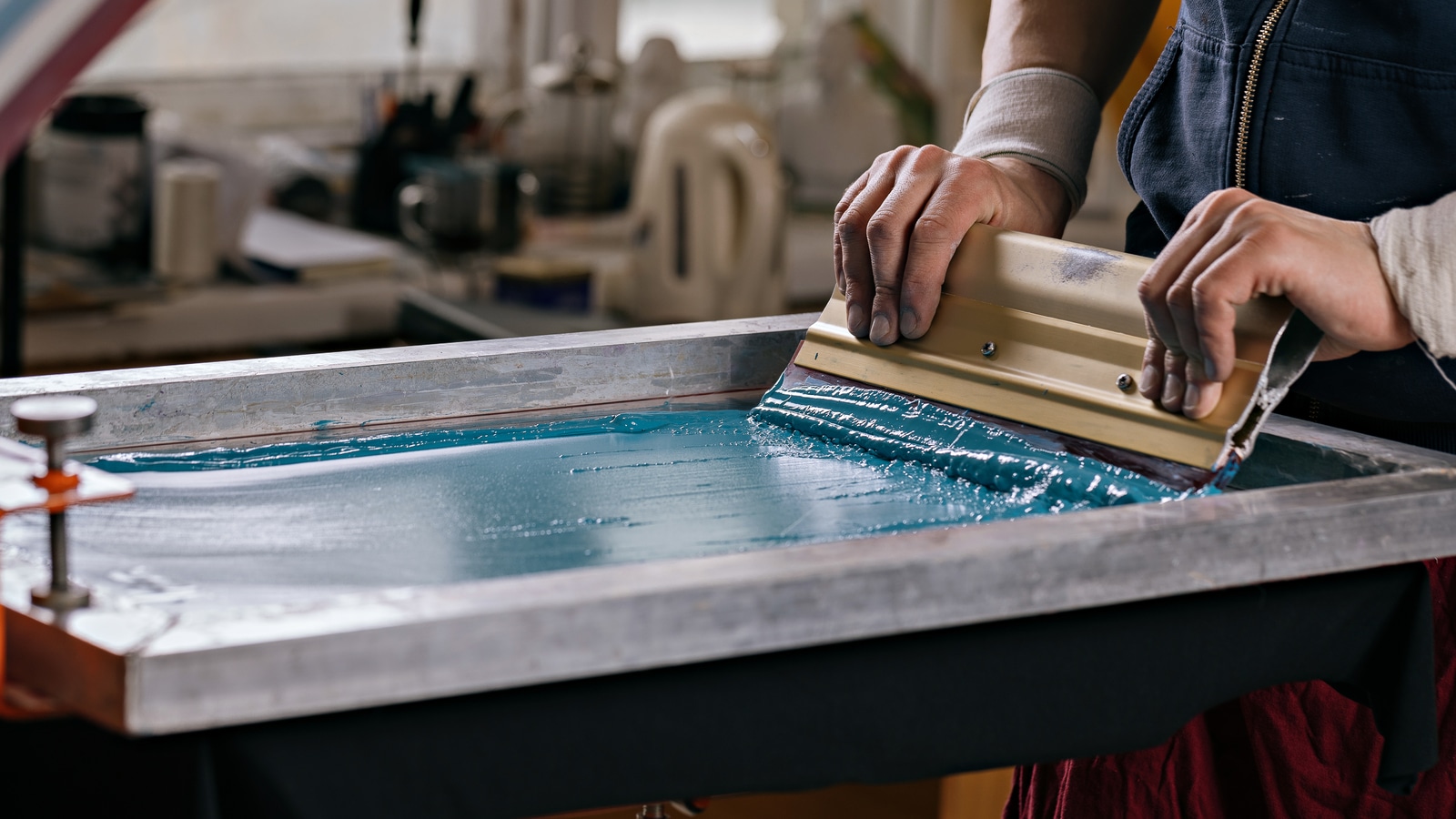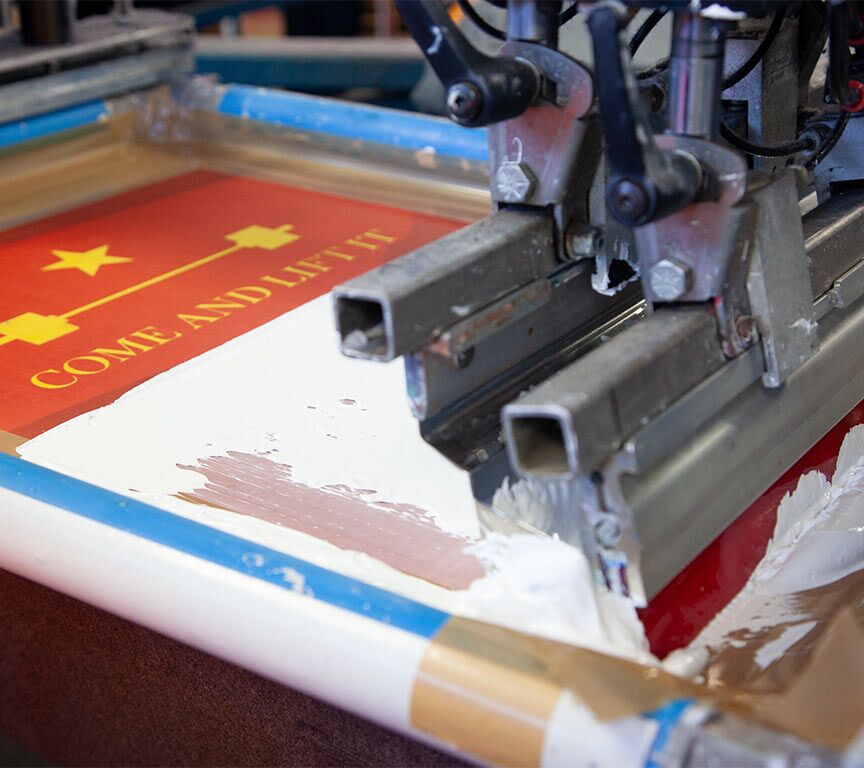Screen Printing Uncovered: Everything You Need to Know About Tee Shirt and Garment Printing Methods
If you have actually ever before asked yourself just how those vivid designs wind up on your favorite t-shirts, you remain in the appropriate area. Display printing is a remarkable approach that incorporates art with technique, using endless possibilities for creative thinking. Recognizing the fundamentals, from tools to ink selections, can greatly impact your outcomes. All set to check out the vital elements that make display publishing an art type? Allow's discover the details that can boost your jobs.
The Basics of Display Printing: How It Works
When you dive into display printing, you'll uncover it's both a science and an art. At its core, display printing involves developing a stencil, or display, that permits ink to pass with just in particular areas.
Position the screen over the material, then utilize a squeegee to press ink via the display onto the garment. Each action is crucial, and mastering them will elevate your screen printing skills, transforming basic garments right into one-of-a-kind, meaningful items.
Sorts Of Display Printing Strategies
Once you grasp the basics of screen printing, it's time to explore the various methods that can raise your layouts. One preferred method is conventional screen printing, where ink is pushed through a stenciled screen. This method is wonderful for bold, vivid shades. There's water-based ink printing, which provides a softer feel and is environmentally friendly, but it requires a various technique to treating.
If you're aiming for fine information, think about discharge printing. This method eliminates dye from the fabric, leaving a soft, classic appearance. One more option is plastisol printing, known for its toughness and brilliant colors, making it a favorite for many brand names. Experiment with halftone printing to create slope effects and detailed styles. Each strategy has its distinct beauty, so don't wait to try them bent on find what matches your style best!
Vital Tools for Display Printing
To accomplish stunning results in display printing, having the appropriate equipment is fundamental. You'll need a durable screen printing framework, which holds the mesh that transfers your design onto the garment. Next, invest in high-grade mops; these are vital for applying ink equally throughout the screen.
Choosing the Right Inks and Products
When selecting inks and materials for display printing, you require to take into consideration the sort of ink that functions finest for your job. Think concerning textile compatibility to ensure your designs look fantastic and last long. Additionally, check out environment-friendly ink choices to make your printing process extra sustainable.
Kinds of Display Inks
Choosing the right display ink is vital for accomplishing vibrant, sturdy prints that fulfill your project's requirements. There are a number of types of display inks to analyze. Plastisol ink is preferred for its flexibility and convenience of use, giving outstanding shade opacity on dark fabrics. Water-based ink, on the various other hand, offers a softer feeling and is eco-friendly, making it excellent for those wanting to decrease their environmental influence. Discharge inks eliminate color from the fabric, leading to a soft, classic look however call for particular handling. Ultimately, specialty inks, such as glow-in-the-dark or metal, can add one-of-a-kind impacts to your designs. Examine your task requirements and choose the ink that lines up ideal with your desired outcome.

Textile Compatibility Considerations
Recognizing fabric compatibility is essential for attaining high-grade screen prints, specifically since various products react distinctly to various inks. When picking inks, think about the fabric kind-- cotton, polyester, or blends. For cotton, water-based inks work well, offering gentleness and breathability. Polyester, on the other hand, usually calls for plastisol inks for much better attachment and lively colors. You could require to use a combination of both types if you're printing on blends. Always examine your inks on example material to guarantee they stick effectively and maintain shade integrity. Furthermore, bear in mind that material weight and texture can impact the last outcome, so picking the best ink and product combo is crucial for your job's success.
Eco-Friendly Ink Options
Green inks are ending up being a preferred selection for display printers that intend to minimize their environmental effect while keeping quality. When choosing inks, take into consideration water-based inks, which are much less harmful and easier to tidy up compared to conventional solvents. These inks bond well with fabrics, supplying lively outcomes without poisonous chemicals. You might likewise explore eco-solvent inks that use less unstable natural compounds (VOCs), making them a much safer choice for both your health and wellness and the earth.
Additionally, look for inks made from eco-friendly resources, such as soy or vegetable-based alternatives. By picking the best inks and materials, you'll not just develop sensational styles but additionally add to an extra sustainable printing procedure. Make the button, and your prints will certainly reflect your dedication to the environment!
Preparing Your Style for Screen Printing

File Layout Demands
To assure your style looks vivid and sharp on material, you'll need to pay attention to file style requirements for screen printing. Start with vector documents like AI or EPS, as they can be scaled without shedding high quality. If you utilize raster photos, choose high-resolution data, such as TIFF or PNG, ideally at 300 DPI. Stay clear of utilizing JPEGs, as they can lose quality when resized. Also, make certain your layout has a transparent history to avoid unwanted white edges on your prints. Ultimately, keep color settings in mind; CMYK is basic for screen printing, so convert your RGB creates as necessary. By complying with these guidelines, you'll set your artwork up for a successful print.
Color Separation Techniques
Color splitting up is an important step in preparing your layout for display printing, and mastering it can considerably enhance your print quality. You'll need to break your style right into specific colors, as each color calls for a different screen during printing. Beginning by recognizing all the colors in your design and develop layers each. You can use software like Adobe Photoshop or Illustrator to separate and separate shades properly. Be specific to save each layer as a different data, usually in a format like TIFF or PSD. This accuracy not just guarantees exact shade representation yet likewise enhances the printing process. By paying interest to color splitting up, you'll accomplish dynamic and professional cause your screen-printed garments.
Resolution and Size
Accomplishing the very best lead to display printing starts with assuring your design has the ideal resolution and dimension. Preferably, your artwork needs to go to the custom screen printing very least 300 DPI (dots per inch) for sharp, clear prints. Your last item could look less than professional and pixelated. if you make use of lower resolution.
When it pertains to dimension, consider the dimensions of your print area. Style your art work to match the last print dimension, ideally creating it in the actual dimensions you'll be publishing. In this manner, you'll avoid any type of unanticipated scaling concerns.
Always inspect your style in both vector and raster layouts. Vector graphics can be scaled without losing high quality, making them perfect for display printing. Preparing appropriately will guarantee your design looks amazing on every garment!
Step-by-Step Screen Printing Refine
Display printing is a vibrant procedure that allows you to create vibrant styles on different surfaces. To begin, you'll need a screen, solution, and your picked ink. Initially, prepare your display by cleansing it completely. Next, apply the solution equally and allow it completely dry in a dark location. When dry, subject your screen to light with your design put on it, which will solidify the solution where the light hits, creating a stencil - screen printing kit.
Pour ink onto the screen and use a squeegee to press the ink via the pattern onto the textile. Raise the screen carefully and let the print dry. You've successfully screen published your style.
Tips for Successful Screen Printing Projects
While you're diving right into your display printing projects, bear in mind that prep work is essential to success. Begin by collecting all your materials-- inks, squeegees, screens, and garments. A clean work space helps stop undesirable errors, so clean prior to you start.
Following, validate your artwork is high-resolution and properly sized for your garment. Evaluate your screen for correct exposure and tidy it thoroughly to prevent smudges. When mixing your inks, adhere to the maker's guidelines to attain the best consistency.
Throughout printing, apply even pressure with your squeegee for regular outcomes. Don't rush; take your time to validate each print fulfills your criteria. After printing, let your garments dry totally before taking care of or packaging them.
Finally, constantly keep a sample of your help future reference. By doing this, you can examine your development and boost your strategies gradually. Satisfied printing!

Regularly Asked Inquiries
For how long Does It Require To Establish a Display Printing Task?
Establishing up a display printing task normally takes around 30 mins to an hour. You'll prepare the displays, mix inks, and change journalism. The time varies based on complexity and experience, so stay arranged!
Can I Print on Various Material Keys In Utilizing the Same Technique?
Yes, you can publish on various textile types using the exact same strategy, however you'll need to change your setups and inks. Some materials soak up ink in different ways, so exploring guarantees the most effective results for each and every material.
What Prevail Errors to Stay Clear Of in Display Printing?
When screen printing, stay clear of usual blunders like using the incorrect ink, overlooking appropriate direct exposure times, or skipping pre-press checks. Constantly evaluate your arrangement and maintain tidy displays to guarantee quality outcomes each time.
Just How Can I Properly Clean and Keep My Screen Printing Tools?
To appropriately clean and keep your display printing equipment, you need to frequently wash screens with suitable solvents, inspect squeegees for wear, and ensure all tools are kept dust-free and dry. Consistency enhances and avoids expensive repairs efficiency.
Is Screen Printing Eco-friendly Contrasted to Other Methods?
Screen printing can be extra eco friendly than various other methods, especially if you make use of eco-conscious materials and water-based inks. By picking lasting products and practices, you minimize waste and minimize your influence on the planet.
Display Printing Uncovered: Whatever You Required to Know About Tee Shirt and Garment Printing Strategies
At its core, screen printing includes producing a stencil, or screen, that permits ink to pass via just in specific areas. Placement the screen over the fabric, after that make use of a squeegee to push ink with the screen onto the garment. One prominent technique is typical display printing, where ink is pressed with a stenciled display.When selecting inks and materials for screen printing, you need to take into account the type of ink that works best for your project.